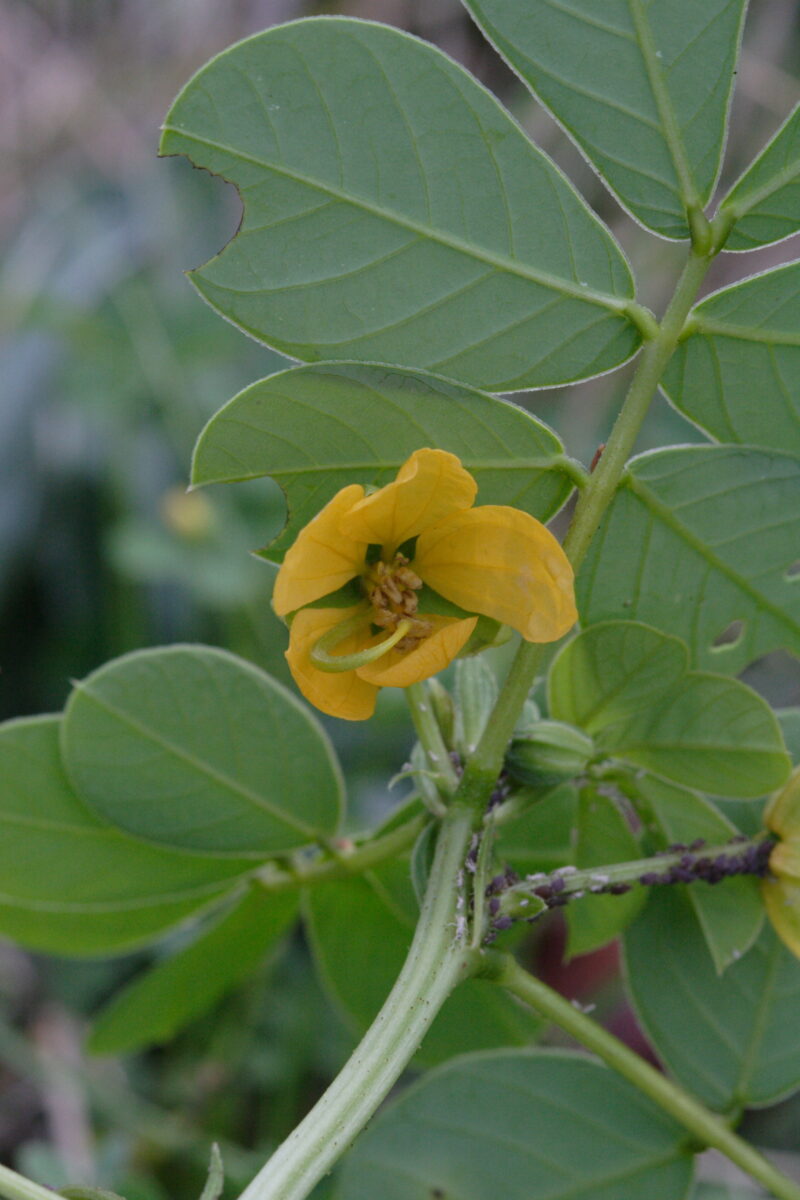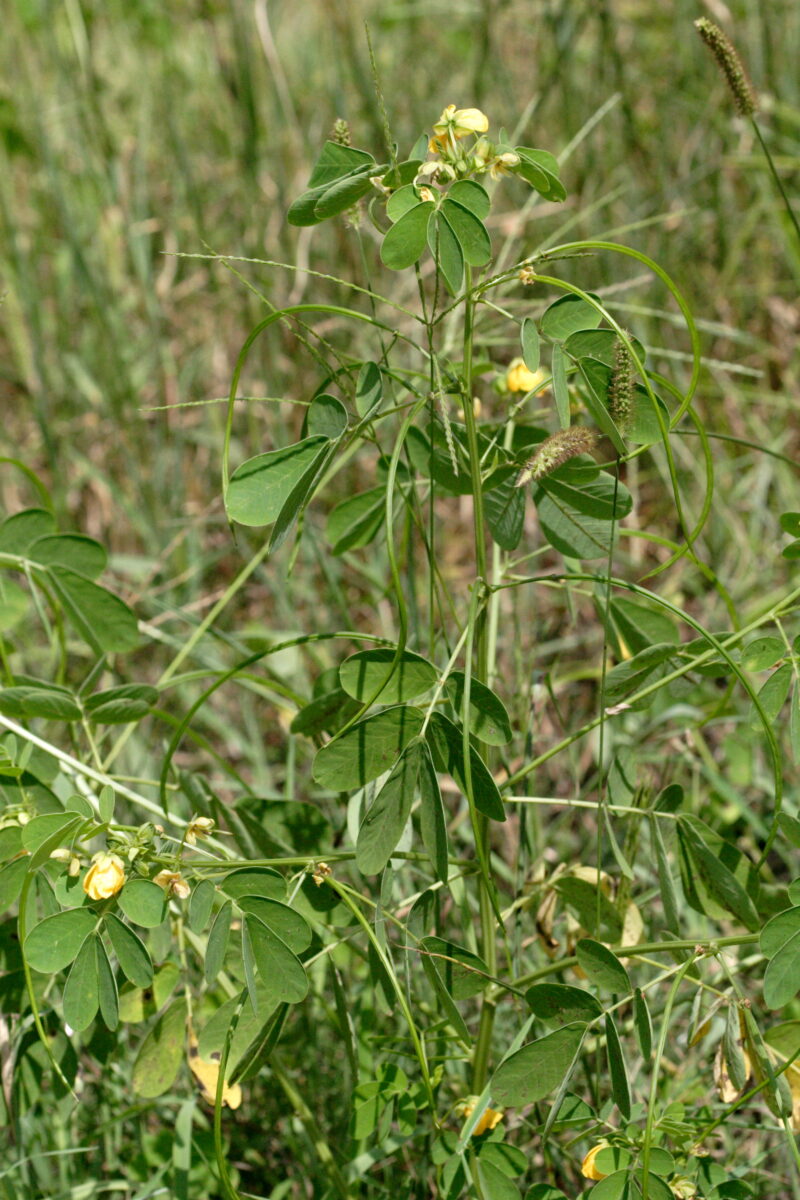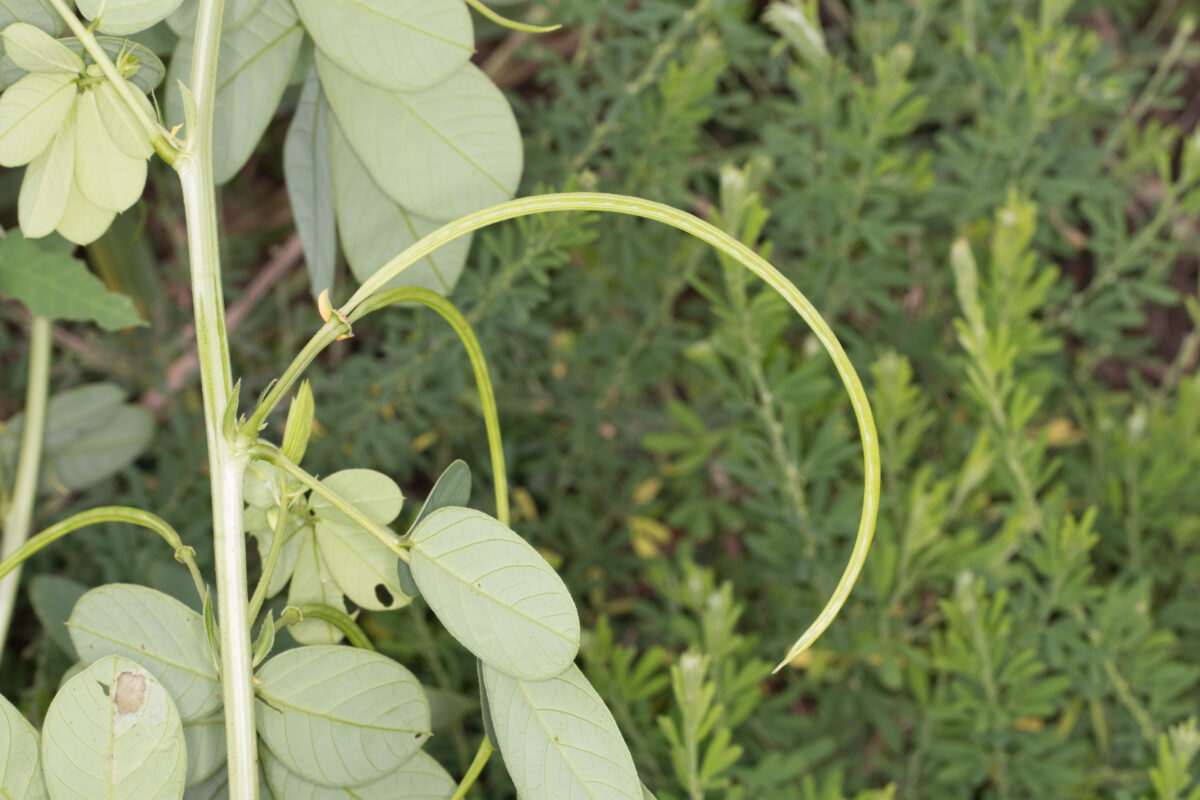Other common names: coffeebean, javabean, coffeeweed



Senna obtusifolia (L.) Irwin & Barneby = Cassia obtusifolia L.
Identification of Sicklepod
Family: Legume family, Fabaceae. Some botanists separate this genus and its relatives, most of which are woody, into the Caesalpinia family, Caesalpiniaceae.
Habit: Upright or sprawling summer annual herb or marginally perennial shrub with compound leaves
Description: Seedling cotyledons are large and round, 0.6–0.8 inch wide, with three to five prominent, pale veins radiating from the base in a hand-like pattern. The first true leaves are divided, with two to three pairs of short-stalked, oval to egg-shaped, hairless leaflets. Mature plants are 1–6 feet tall and sprawling to upright. Stems are green, angular, hairless and occasionally branching. Older stems may become woody at the base. Leaves similar to those of young plants, with three to four pairs of leaflets and two 0.6 inch-long, leafy bracts at the base. Each leaflet is 1–3.5 inches long by 0.5–1 inch wide; leaflets at the tip of the leaf are generally larger than those at the base. A 0.03–0.1 inch-long, orange/brown gland is present at the base of the lowest pair of leaflets. The branching taproot can reach up to 3.3 feet in length. All parts of the plant give off a distinctive odor when crushed. Yellow, showy flowers with 0.3–1 inch-long stalks develop singly or in pairs from the upper leaf axils. Flowers are five-petaled and 0.4–1 inch wide. Petals are 0.3–0.8 inch long, narrowest at the base and have at least three prominent veins. The seedpod is four sided, curved downward, hairless and 3–8 inches long by 0.12–0.25 inch wide. Seedpods split when ripe, releasing 20–40 seeds. Seeds are 0.1–0.25 inch long, brown, glossy and rectangular to irregular in shape.
Similar species: Coffee senna [Senna occidentalis (L.) Link] and partridge-pea [Chamaecrista fasciculata (Michx.) Greene] have similar flowers and foliage to sicklepod. Coffee senna leaflets are larger, up to 3 inches long and 1.5 inch wide, and more numerous (three to seven pairs per leaf) than those of sicklepod, and they have pointed rather than rounded tips. Coffee senna seedpods are cylindrical or flattened rather than angular, and they are curved upward. Partridge-pea cotyledons are spade shaped rather than round and have tapered, bluntly pointed ends. Mature partridge pea leaves have eight to 15 pairs of leaflets that are much smaller, up to 0.7 inch long by 0.3 inch wide, than those of sicklepod. Partridge-pea pods are only slightly curved.
Management of Sicklepod
Rotation to winter and spring cereal grains helps suppress sicklepod populations since the grain will be highly competitive by the time the sicklepod germinates and will be harvested before the weed can produce seeds. A tilled fallow after grain harvest can flush seedlings out and kill them.
If sicklepod produces seeds, leave them on or very near the soil surface in the fall to encourage seed predation and weathering of the resistant seed coat. When preparing a seedbed for a spring row crop, till shallowly; deep plowing will bury seeds for the current year, but many will survive and emerge in subsequent years. If deep tillage is necessary, rip with as little inversion as possible. Note also that shallow seedbed preparation will put the sicklepod seeds closer to the soil surface so that they are more vulnerable to in-row weeding after planting.
Plant spring row crops as early as will allow good establishment. Soybeans and corn, in particular, can emerge from substantially cooler soil than sicklepod, and this gives these crops a head start over the weed. High density planting of soybeans, for example 395,000 per acre rather than 264,000 per acre, has been shown to help competitively suppress this weed. Reports vary on the effectiveness of narrow row spacing for suppressing sicklepod, but at least one study has shown substantial reduction in density and dry weight with 7.5-inch row spacing as compared with 38-inch row spacing. Since many sicklepod seedlings emerge from below the normal planting depth of row crops, in-row weeding should focus on breaking or burying young sicklepod, rather than uprooting them. Consequently, a shallow sweep cultivator, rolling cultivator or tine weeder with relatively stiff tines will be more effective than a rotary hoe or tine weeder with highly flexible tines. Cultivate shallow and close to the row, but throw enough soil toward the row to bury late emerging plants if the crop will tolerate this. Cotton rows can be flame weeded to eliminate late emerging sicklepod. Late emerging weeds will not be very competitive, except perhaps in a drought year, but the seeds they produce can pose problems for future crops in the rotation.
The seeds provide sufficient energy to allow seedlings to penetrate even dense layers of straw mulch, but synthetic mulches are effective barriers against sicklepod in vegetable crops. Distillery wastewater applied as a fertility amendment at 1 gallon per square foot suppressed sicklepod emergence by 87% and post-emergence survival by 65%.
Sicklepod can be a problem in poorly managed pastures and a severe problem in high traffic areas such as around hay rings or feed bunks, but a vigorous sward will outcompete the weed. Trampling during intensive rotational grazing will kill sicklepod even though they are not eaten. Mowing the pasture when sicklepod is about to flower will eliminate or greatly retard seed production.
Ecology of Sicklepod
Origin and distribution: Sicklepod is native to tropical and subtropical parts of South and North America. It is widely introduced in warmer parts of Africa, Asia and Australia. In the United States it is common throughout the Southeast as far north as Tennessee and Virginia, and it occurs sporadically northward to Wisconsin and New York, westward to Nebraska, and in southern California. It is most problematic in the Southeast.
Seed weight: 23–28 mg.
Dormancy and germination: Sicklepod seeds have a hard, waxy seed coat that prevents absorption of water, thereby preventing germination of most seeds. On average, only about 10% of seeds with intact seed coats will germinate, but germinability varies. Damage to the seed coat promotes germination. In one experiment, incubation of the seeds in wet sand for 12 months increased germination from 5% to 15%, indicating that the seed coat slowly breaks down over time. Fire cracks the seed coat and can prompt high germination following the next rain. Scarified seeds germinate well from 68–97°F but poorly below 59°F or above 104°F. Development of a soybean canopy greatly reduced mid- to late-season emergence of sicklepod seedlings, possibly due to lower soil temperatures or decreased temperature fluctuations under the crop canopy. Rapid seedling emergence occurs at temperatures from 81–97°F. Light does not affect germination if the seed coat is damaged, but light may further inhibit germination of intact seeds. Seeds germinate best at pH 5–8, but a few will germinate at pH 3–9.
Seed longevity: Due to its hard seed, sicklepod forms a persistent seed bank, and as much as 270 pounds per acre of seeds have been recovered from soil samples. Sicklepod seeds had 46% mortality over a two-year period when soil was tilled annually in late fall and early spring, but only 28% mortality when the soil was undisturbed. Seed mortality was computed to be 40% per year based on seed burial studies for 5.5 years in Mississippi. Annual spring tillage followed by repeated disking through the summer depleted the seed bank more rapidly than annual fall tillage followed by a chemical fallow without soil disturbance during the summer.
Season of emergence: In Arkansas, seedlings emerge from late May to August.
Emergence depth: Sicklepod emerges relatively well from below the planting depth of most crops. In one study, emergence was high at depths to 3 inches, and about 15% of seeds buried at 5 inches produced seedlings. Emergence was faster, however, from shallow depths. In another study seedling emergence was high down to 1.5 inch, and a few seedlings emerged from 4 inches, but the emergence response to burial depth varied with soil texture.
Photosynthetic pathway: C3
Sensitivity to frost: Day/night temperatures of 84/70°F or lower greatly inhibit growth of sicklepod relative to higher temperatures, and growth ceases at mean daily temperatures below 57°F.
Drought tolerance: Sicklepod is able to germinate at low moisture potential. Although initial root elongation is slowed by low moisture, enough growth occurs even under drought conditions that the roots can grow into deeper soil layers with more moisture. Sicklepod tends to have a higher root-to-shoot ratio than soybeans, which probably gives it a competitive advantage under drought conditions, but several physiological characteristics related to photosynthesis and transpiration are intermediate compared to other C3 weeds.
Mycorrhiza: Sicklepod is mycorrhizal.
Response to fertility: Although sicklepod is a legume it does not host nitrogen-fixing bacteria. Application of 200 pounds per acre of N to an N-deficient soil increased dry weight of sicklepod by 59% and seed production by 114%. Seeds produced under low N fertility were smaller and grew into less competitive plants than seeds produced under high N. Its response to N-P-K fertility is greater than soybean and about equal to cotton. Although sicklepod growth is somewhat reduced at low and high pH, it grows reasonably well at soil pH as low as 3.2 or as high as 7.9.
Soil physical requirements: The species commonly occurs in soil with textures that range from loams to gravels. It seems particularly associated with coarse soils like sandy agricultural fields and the gravel of railroad ballast. It is highly tolerant of compacted layers in the soil.
Response to shade: Partial shading of 47% or 65% decreased dry weight of sicklepod but induced plant height to increase by 32%, showing that this species can often grow out from under a partial crop canopy. Shade of 80% reduced dry weight more than 75% of plants growing in full sun, and 95% shade suppressed sicklepod almost completely.
Sensitivity to disturbance: If sicklepod plants in a subtropical climate are cut, they may persist as short lived perennials.
Time from emergence to reproduction: Flowering is hastened when days are shorter than 12 hours. Flowering occurs six to 12 weeks after emergence, with northern populations (e.g., Tennessee) flowering more quickly than southern populations (e.g., Florida).
Pollination: Although the flowers are heavily visited by bees, self-pollination usually occurs before the flowers open.
Reproduction: In a comparison of populations from across the South grown with minimal competition, the mean number of seeds per pod was 26 and varied little between populations and years. The number of pods per plant varied from 63–591, with substantial variation between years and with more pods produced by southern (e.g., Louisiana or Florida) than more northern populations (e.g., Tennessee or North Carolina). Consequently, the number of seeds per plant varied from 1,500–16,000. Sicklepod grown without interference produced 11,420 seeds per plant in Arkansas. Plants growing in conventionally tilled soybeans in Alabama averaged 176 pods per plant. A dense stand can produce over 2,700 pounds per acre of seed.
Dispersal: The pods can throw seeds up to 16 feet as they open. Seeds are carried by stream water, overland flow and in mud attached to the feet and fur of animals. They also move in contaminated mulch and in mud on machinery, vehicles and footwear. Although the species is generally unpalatable, livestock nibble on the pods, and seeds will pass through the animals and disperse when the animals are moved.
Common natural enemies∫ Sicklepod seeds are attacked by the beetle Sennius fallax. Caterpillars of several species of sulphur butterflies feed on the foliage, including little sulphur (Eurema lisa), sleepy orange (Eurema nicippe) and cloudless sulfur (Phoebis sennae cubule). Alternaria cassiae causes seedling blight in sicklepod and is a potential mycoherbicide. A mixture of spores of the anthracnose fungi Colletotrichum truncatum and C. Gloeosporioides in corn oil and a surfactant effectively controls sicklepod.
Palatability: Sicklepod is cultivated in Africa for the young shoots, which are eaten as a pot herb. Sicklepod is unpalatable to livestock and can cause poisoning if eaten. The seeds are toxic and pose a serious threat to chickens and pigs when they contaminate feed.
Note: Sicklepod residue inhibits the germination and seedling growth of cotton and other crops.
Summary Table of Sicklepod Characteristics
| Sicklepod | ||||||||
|---|---|---|---|---|---|---|---|---|
| Growth habit | Seed weight (mg) | Seed dormancy at shedding | Factors breaking dormancy | Optimum temperature for germination (F) | Seed mortality in untilled soil (%/year) | Seed mortality in tilled soil (%/year) | Typical emergence season | Optimum emergence depth (inches) |
| medium, branched | 23–28 | Yes | scd | 68–97 | 28–40 | 46 | late spring to summer | 0–3 |
| Photosynthesis type | Frost tolerance | Drought tolerance | Mycorrhiza | Response to nutrients | Emergence to flowering (weeks) | Flowering to viable seed (weeks) | Pollination | Typical & high seed production (seeds per plant) |
| C3 | low | moderate | yes | moderate | 6–12 | na | both | 5,000 & 16,000 |
Table Key
General: The designation “–” signifies that data is not available or the category is not applicable.
Growth habit: A two-word description; the first word indicates relative height (tall, medium, short, prostrate) and second word indicates degree of branching (erect, branching, vining).
Seed weight: Range of reported values in units of “mg per seed.”
Seed dormancy at shedding: “Yes” if most seeds are dormant when shed, “Variable” if dormancy is highly variable, “No” if most seeds are not dormant.
Factors breaking dormancy: The principle factors that are reported to break dormancy and facilitate germination. The order of listing does not imply order of importance. Abbreviations are:
scd = seed coat deterioration
cms = a period subjected to cold, moist soil conditions
wst = warm soil temperatures
li = light
at = alternating day-night temperatures
ni = nitrates
Optimum temperature range for germination: Temperature (Fahrenheit) range that provides for optimum germination of non-dormant seeds. Germination at lower percentages can occur outside of this range. The dash refers to temperature range, and the slash refers to alternating day/night temperature amplitudes.
Seed mortality in untilled soil: Range of mortality estimates (percentage of seed mortality in one year) for buried seeds in untilled soil. Values were chosen where possible for seeds placed at depths below the emergence depth for the species and left undisturbed until assessment. Mortality primarily represents seed deterioration in soil.
Seed mortality in tilled soil: Range of mortality estimates (percentage of seed mortality in one year) for seeds in tilled soil. Values were chosen for seeds placed within the tillage depth and subjected to at least annual tillage events. Seed losses are the result of dormancy-breaking cues induced by tillage, germination and deterioration of un-germinated seeds.
Typical emergence season: Time of year when most emergence occurs in the typical regions of occurrence for each weed. Some emergence may occur outside of this range.
Optimum emergence depth: Soil depths (in inches below the soil surface) from which most seedlings emerge. Lower rates of emergence usually will occur at depths just above or just below this range.
Photosynthesis type: Codes “C3” or “C4” refer to the metabolic pathway for fixing carbon dioxide during photosynthesis. Generally, C3 plants function better in cooler seasons or environments and C4 plants function better in warmer seasons or environments.
Frost tolerance: Relative tolerance of plants to freezing temperatures (high, moderate, low).
Drought tolerance: Relative tolerance of plants to drought (high, moderate, low).
Mycorrhiza: Presence of mycorrhizal fungi. “Yes” if present; “no” if documented not to be present, “unclear” if there are reports of both presence and absence; “variable” if the weed can function either with or without, depending on the soil environment.
Response to nutrients: Relative plant growth response to the nutrient content of soil, primarily N, P, K (high, moderate, low).
Emergence to flowering: Length of time (weeks) after emergence for plants to begin flowering given typical emergence in the region of occurrence. For species emerging in fall, “emergence to flowering” means time from resumption of growth in spring to first flowering.
Flowering to viable seed: Length of time (weeks) after flowering for seeds to become viable.
Pollination: “Self” refers to species that exclusively self-pollinate, “cross” refers to species that exclusively cross-pollinate, “self, can cross” refer to species that primarily self-pollinate, but also cross-pollinate at a low rate, and “both” refers to species that both self-pollinate and cross-pollinate at relatively similar rates.
Typical and high seed production potential: The first value is seed production (seeds per plant) under typical conditions with crop and weed competition. The second value, high seed production, refers to conditions of low density without crop competition. Numbers are rounded off to a magnitude that is representative of often highly variable reported values.
Further Reading
Bararpour, M.T. and L.R. Oliver. 1998. Effect of tillage and interference on common cocklebur (Xanthium strumarium) and sicklepod (Senna obtusifolia) population, seed production, and seed bank. Weed Science 46: 424–431.
Bridges, D.C. and R.H. Walker. 1985. Influence of weed management and cropping systems on sicklepod (Cassia obtusifolia) seed in the soil. Weed Science 33: 800–804.
Nice, G.R.W., N.W. Buehring and D.R. Shaw. 2001. Sicklepod (Senna obtusifolia) response to shading, soybean (Glycine max) row spacing, and population in three management systems. Weed Technology 15: 155–162.

